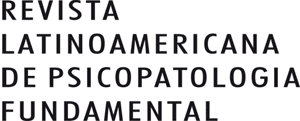Resumos
A terceira versão do Diagnostic and Statistic Manual of Mental Disorders (DSM III), publicado pela American Psychiatric Association em 1980, implicou uma mudança de paradigma no conhecimento psiquiátrico vigente, tanto nos Estados Unidos quanto no contexto internacional em geral. Apresentamos um pequeno histórico dessa transformação e procuramos expor e discutir a nova arquitetura do manual e sua lógica classificatória. Construímos nossa argumentação em torno do destino reservado às antigas “neuroses” e aos novos “transtornos sexuais”.
DSM III; diagnóstico; história da psiquiatria
La tercera versión del Diagnostic and Statistic Manual of Mental Disorders (DSM III), publicado por la American Psychiatric Association en 1980, implicó un cambio de paradigma en el conocimiento psiquiátrico vigente, tanto en los Estados Unidos como en el contexto internacional en general. Presentamos un pequeño histórico de esa transformación y buscamos exponer y discutir la nueva arquitectura del manual y su lógica clasificatoria. Construimos nuestra argumentación alrededor del destino reservado a las antiguas “neurosis” y a los nuevos “trastornos sexuales”.
Historia de la psiquiatría; diagnóstico; DSM III
La troisième version du Diagnostic and Statistic Manual of Mental Disorders (DSM III), publié par l’ American Psychiatric Association en 1980 a entraîné un changement de canon dans le savoir psychiatrique, non seulement aux États Unis, mais aussi dans les autres pays du monde. Nous présentons l’histoire résumeé de cette transformation, en analisant le changement de l’architecture et de la logique sous-jacente du manuel. Notre argumentation est centrée sur le nouveau statut des névroses et des “troubles sexuels”.
Histoire de la psychiatrie; diagnostique; DSM III
The third edition of the Diagnostic and Statistic Manual of Mental Disorders (DSM III), published by the American Psychiatric Association in 1980, brought about a paradigmatic change in psychiatric knowledge in the United States, as well as in other countries around the world. In this article we present a short history of this change, and discuss the new architecture of the manual and its logic of classification. Our argument focuses around the way the concepts of “neurosis” and “sexual disorders” were dealt with in the latest version of the manual.
History of psychiatry; diagnosis; DSM III
Texto completo disponível apenas em PDF.
Referências
- AMERICAN PSYCHIATRIC ASSOCIATION. Diagnostic and Statistical Manual of Mental Disorders, 1952.
- AMERICAN PSYCHIATRIC ASSOCIATION. Diagnostic and Statistical Manual of Mental Disorders 2. ed. 1968.
- AMERICAN PSYCHIATRIC ASSOCIATION. Diagnostic and Statistical Manual of Mental Disorders 3. ed. 1980.
- AMERICAN PSYCHIATRIC ASSOCIATION. DSM IV – Manual diagnóstico e estatístico de transtornos mentais. 4a ed. Porto Alegre: Artes Médicas, 1995.
- BAYER, Ronald. Homossexuality and American Psychiatry. New Jersey: Princeton University Press, 1987.
- BAYER, Ronald e SPITZER, Robert. Neurosis, psychodinamics and DSM III. Arch. Gen. Psychiatry, v. 42, p. 187-96, fev. 1985.
- BENTO, Berenice. Da transexualidade oficial às transexualidades In: CARRARA, S.; GREGORI, M. F. e PISCITELLI, A. Sexualidades e saberes: convenções e fronteiras. Rio de Janeiro: Garamond, 2004.
- BORGES, Jorge Luis. Del rigor de la ciencia In: El Hacedor Buenos Aires: Emecé, 1960.
- FOUCAULT, Michel. História da sexualidade I: a vontade de saber. Rio de Janeiro: Graal, 1977.
- GAINES, Atwood D. From DSM I to III R; Voices of self, mastery and the other: a cultural constructivist reading of U.S. Psychiatric Classification. Social Science and Medicine, v. 35, n. 1, p. 3-24, 1992.
- HEALY, David. The anti-depressant era. Cambridge: Harvard University Press, 1997.
- KUTCHINS, Herb & KIRK, Stuart. Making us Crazy – DSM: The Psychiatric Bible and the Creation of Mental Disorders. New York: The Free Press, 1999.
- LANTERI-Laura, Georges. Leitura das perversões. Rio de Janeiro: Jorge Zahar, 1994.
- OOSTERhuis, Harry. Richard von Kraft-Ebing’s “step-children of nature”: psychiatry and the making of homosexual identity. In: ROSARIO, V. (org.). Science and Homossexualities. New York: Routledge, 1997.
- RUSSO, Jane. Do desvio ao transtorno: a medicalização da sexualidade na psiquiatria contemporânea In: CARRARA, S.; GREGORI, M. F. e PISCITELLI, A. Sexualidades e saberes: convenções e fronteiras. Rio de Janeiro: Garamond, 2004.
- RUSSO, Jane & HENNING, Marta. O sujeito da “psiquiatria biológica” e a concepção moderna de pessoa. Antropolítica, 6, p. 39-56, 1o semestre 1999.
- SHORTER, Edward. A History of Psychiatry: from the era of the asylum to the age of Prozac. New York: John Wiley and Sons, 1997.
- SWAIN, Gladys (1987). Chimie, cerveau, esprit et société – Paradoxes épistémologiques des psychotropes en médecine mentale. In: Dialogue avec l’insensée. Paris: Galimard, 1994.
- TERRY, Jennifer. The seductive power of science in the making of deviant subjectivity. In: ROSARIO, V. (org.). Science and Homossexualities. New York: Routledge, 1997.
- VENANCIO, Ana Teresa A. O eu dividido moderno: uma análise antropológica da categoria esquizofrenia. 1998. Tese (doutorado), PPGAS, Museu Nacional/UFRJ.
- WILSON, M. DSM III and the transformation of american psychiatry: a history. American Journal of Psychiatry, v. 150, n. 3, p. 399-410, 1993.
- YOUNG, Allan. The Harmony of Illusions: Inventing Post-traumatic Stress Disorder. New Jersey: Princeton University Press, 1995.
Datas de Publicação
-
Publicação nesta coleção
Jul-Sep 2006
Histórico
-
Recebido
Jan 2006 -
Aceito
Abr 2006

